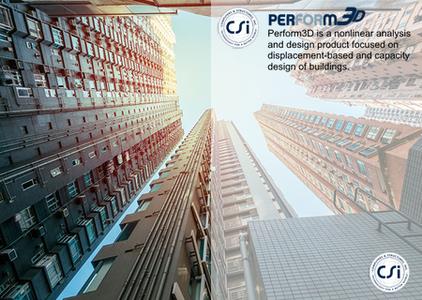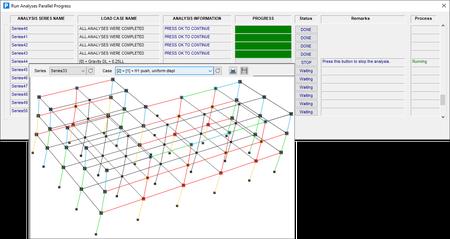CSI Perform3D 9.0.0 (1198) Win x64

Free Download CSI Perform3D 9.0.0 (1198) | 241.0 mb
Product:CSI Perform3D
Version:9.0.0 (1198)
Supported Architectures:x64
Website Home Page :www.csiamerica.com
Languages Supported:english
System Requirements:Windows *
Size:241.0 mb
Computers and Structures, Inc. (CSI) is pleased to announce the availability of CSI Perform3D 9.0.0 (1198). This release increase the number of parallel runs that can be queued, and corrects a number of issues reported by users.
Perform3D 9.0.0 Enhancements - Date: 28-Apr-2023
Data Files and Analysis
The maximum number of parallel Analysis Series that can be queued and run has been increased from 32 to 50.

This document lists changes made to Perform3D since v8.1.0, released 19-July-2022. Items marked with an asterisk (*) in the first column are more significant.
9090The maximum number of parallel Analysis Series that can be queued has been increased from 32 to 50. If more than this maximum number is requested to be run, the first 50 will be queued and a corresponding message will be displayed. In addition, the Run Analyses Parallel Progress form has been improved so that all queued Analysis Series can be viewed using the scroll bar. Previously on the first 14 Analysis Series could be seen due to a vertical scroll-bar limit.
9081The version number has been changed to v9.0.0 for a new major release. Models from versions prior to v7 will need to be opened and saved in v7 before they can be opened in v9.
9186An incident was resolved where an abnormal termination could occur if a model with no analysis series defined enters the Run Analyses Parallel task (Analysis phase). This issue was noted to occur for some models that were exported from ETABS.
9217An incident was resolved where certain models from older versions of Perform-3D (prior to Perform3D v8) would fail to run analyses in parallel after opening in v8, but instead displayed the message "Please set up analysis series run cases first", even though the analysis series were already properly defined.
9192An incident was resolved where Fluid Damper components with the "Generate Coefficient" option enabled would be corrupted when a model created in Perform3D v7 or a prior version is opened in Perform3D v8. This issue caused the first segment of the generated coefficient to be set to zero and, in Perform3D v8, could be resolved by changing the parameters used to generate the coefficients. This issue has been fixed in Perform3D v9.
9221An incident was resolved where the "General Wall Results" database tables did not display. This issue only affected the database tables and did not affect other output for the general wall.
9344An incident was resolved where the "Frame Results - Components" database tables may not display if any of the frame elements selected contained an inelastic fiber section basic component. Results were not affected.
8788An incident was resolved where importing results from another model using the Import Results task (Analysis Phase) could overwrite the results of an analysis series that was not selected for import if that analysis series had not been run in the the imported model. Additionally, in some cases, an issue can occur where the program may experience an abnormal termination error when a model that has not previous run any analyses is used to import results from another model using the Import Results task (Analysis Phase).
8913An incident was resolved where an exported General Wall Component (.PF3CMP file) could not be imported unless there was both a shear material and a diagonal compression material in the component definition, even though both are not required for a valid component definition.
* 9062An incident was resolved where importing nodes and elements from text files using the "Import/Export Structure Data" task (Build phase) was not creating unique node IDs. This could cause all imported nodes to have the same ID (e.g., "N0"). Saved models that had this issue from a previous import will also be corrected when opened in the new version.
9169An incident was resolved that addressed several issues with exporting and importing component properties: (1.) When trying to export a Support Spring component (under the Elastic tab) using the "Selected components of this type" option under the Export Components tab, an error message was displayed that the file could not be created. (2.) Importing a PF3CMP file with a Fluid Damper compound component (under the Compound tab) always gave an error that the dependent components were not available, even when the dependent components were already present in the model, making it impossible to import the compound component. (3.) Importing a PF3CMP file with a BRB compound component (under the Compound tab) always gave an error that the dependent components were not available, even when the dependent components were already present in the model, making it impossible to import the compound component. (4.) Importing a PF3CMP file that was produced by exporting a legal Inelastic Bar component (under the Inelastic tab) from the same version caused an abnormal termination error.
9060An incident was resolved where, in certain cases, displaying time-history results could cause an abnormal termination of the software. When this occurred, restarting Perform3D would usually resolve the problem without any loss of data or results.
9364An incident was resolved where, when an analysis terminated due to a convergence error in a P-M2-M3 hinge component, the associated error message may not be present at the end of the ECHO file produced for the analysis run.
9011An incident was resolved where, in certain rare cases, a model could not be saved using the command File > Save As. In some cases, models affected by this issue may have also experienced abnormal termination errors when viewing results in the Analysis phase.
9174An incident was resolved where an abnormal termination of the software could occur after importing an ETABS model and then importing FEMA steel beam components. The abnormal termination could occur while adding the component or later when trying to run the analysis.
* 9577An incident was resolved for the Strength Section Component definition forms where it was possible to create illegal strength sections that would prevent the model from running. This could occur by creating multiple sections without changing or closing the form. Normal use of the form to create a sequence of unique strength sections would not cause this error.
8763An incident was resolved where the Frame View controls were not visible in Combination and Envelopes task after selecting the Element Color tab.
9376An incident was resolved where values for the parameters "PC", "PT", "DU (at F0)", "Ratio FY/FU", "Exponent for F2-F3 interaction" in the "V2-V3 Shear Hinge, Displacement Type" inelastic component could not be filled for a newly created component

Perform3Dis a structural-engineering software useful for the performance assessment of structural systems. State-of-the-art constitutive-modeling capabilities enable characterization of material nonlinearity, including strength and stiffness degradation during component-level hysteresis. Analysis capabilities also extend to geometric nonlinearity and effects associated with P-Delta behavior. Advanced modeling tools enable a sophisticated simulation of structural behavior. Components may be grouped according to type, location, and limit state before evaluation proceeds in terms of strength or deformation-based demand-capacity ratio. The dynamic display of D-C usage is available through color-coordinated time-history animations. Perform3D is an ideal tool for nonlinear performance-based analysis and design, created by Dr. Graham H. Powell, University of California at Berkeley Professor Emeritus of Civil Engineering.
Performance Based Design - Pt. 1 by Dr. Graham Powell
An Intense & Practical Educational Seminar using CSi's PERFORM-3D Nonlinear Analysis software.
Founded in 1975,Computers and Structures, Inc. (CSI)is recognized globally as the pioneering leader in software tools for structural and earthquake engineering. Software from CSI is used by thousands of engineering firms in over 160 countries for the design of major projects, including the Taipei 101 Tower in Taiwan, One World Trade Center in New York, the 2008 Olympics Birds Nest Stadium in Beijing and the cable-stayed Centenario Bridge over the Panama Canal. CSI's software is backed by more than three decades of research and development, making it the trusted choice of sophisticated design professionals everywhere.
Rapidgator
http://peeplink.in/1e0b70193d9b
Uploadgig
z6oyd.CSI.Perform3D.9.0.0.1198.rar
NitroFlare
z6oyd.CSI.Perform3D.9.0.0.1198.rar
Links are Interchangeable - Single Extraction
